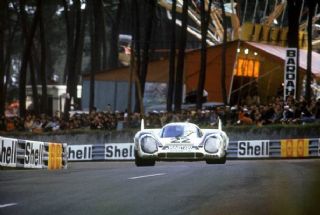From Martini to Red Bull ... Words by Ken Davies. Images courtesy Porsche AG and Red Bull
There can be little doubt that Red Bull Racing’s rapid ascendancy into the pantheon of grand prix constructor ‘greats’ is due in no small part to Adrian Newey’s brilliance as a designer, but that’s not the only reason. The Red Bull team is the sum of many parts and one of these is its strength in depth, largely created by an anonymous but distinguished looking grey-haired gentleman seen lurking unobtrusively in their pit garage during races, assiduously avoiding the glare of publicity but never missing a single item of critical data likely to affect the team and its on-track performance.
Doctor Helmut Marko is this mysterious person, largely known only to students of motor racing history but possessing a ‘top-drawer’ curricula vitae; Le Mans winner, lawyer, business consultant, hotelier, art collector, prominent racing strategist and native of the Austrian region of Styria. A man of 70 summers who has forgotten more about international motor racing than most of us have ever known!

Let’s just take one example. The 1971 Le Mans 24 hours race would become famous for setting a scintillating record of distance and speed that would stand for over 30 years; 5,335 kilometres - 397 laps at an average speed of 222kph, achieved by Helmut Marko and Dutch sports car legend Gijis van Lennep driving the short-tailed, magnesium chassis Martini ‘works’ Porsche 917K which, in the final stages of the race, was locked in a titanic battle with the Gulf-sponsored 917 of Attwood and Muller, Ferrari’s 512M challenge having long since slipped several laps in arrears.
But although Marko loved endurance racing; he was second in the tough 1972 Targio Florio driving an Alfa Romeo T33, his priority at this stage of his career was Formula One and he was a member of the charismatic BRM team, albeit now past its best years.
In the event, fate intervened for the newly qualified doctor of law and whilst competing in the French Grand prix of 1972, Marko was hit in the eye by a stone thrown up by the wheel of another car; race tracks of this period were notoriously dirty and debris ridden and helmet visors did not possess that vital impact resistance that was ironically introduced as a result of the Marko accident. This freak accident resulted in Marko losing his left eye and with it his future as a professional racing driver.
With typical Austrian stoicism; remember Niki Lauda’s reaction following his fiery accident in 1976, Marko quickly turned the page on this phase of his life without a second thought and swiftly moved on, his perception enhanced by the fitment of a tasteful glass eye, seemingly allowing its wearer new perspectives that would encompass business, art, architecture and, of course, motor racing strategy. Significantly, Marko’s wily fellow countryman and three-time world champion Lauda is now team advisor to Mercedes, already the most improved team at this stage of the 2013 season.
As an aside, Marko’s deep interest in art dated back to the 1960s when artists occasionally moved in motor racing circles and he met Frank Stella, Jean Tinguely and even Niki de Saint Phalle. Tinguely actually collected pieces of damaged metal, including cars and incorporated them into his masterpieces of kinetic art. It was during this period that Marko began to acquire works of art and today he possesses a scintillating collection of modern art which he freely shares with guests at his two prestigious hotels in Graz.
Born in 1943, Marko’s experiences at Le Mans and in Formula One were founded in the Jackie Stewart era and that of Marko’s fellow countryman and school friend Jochen Rindt. Both Marko and Rindt attended the same secondary school and were sent to the same boarding school for unruly pupils which, in their case, kick-started successful competition careers, mostly in borrowed vehicles and against the clock.
Following the end of his driving career, Marko gravitated into team management and also invested his own time and money into promoting the talents of promising drivers including Gerhard Berger, Karl Wendlinger and Juan Pablo Montoya, his management style becoming well-known for its hard and uncompromising ethos with a conspicuous lack of easy-going humour!
Over the subsequent decades Marko’s reputation for high quality motor racing analysis, diagnosis and therapy became legendary and it was only logical that Austrian energy drink magnet and Red Bull co-owner Dietrich Mateschitz recruited Marko into his Formula One team as principal consultant, decision maker-at-large and confidant, a status that Marko enjoys without being tied to any particular team duty.
At every grand prix, spectators see ‘da doctor’ lurking anonymously in the back of the Red Bull pit garage, all channels available to his head-set and his keen eye on all monitors, never actually interfering with the operation of the team but studying the strategic nature of the race as it unfolds and the team’s reactions to the many changing scenarios over the two-hour race.
If needed, he will lob in the occasional verbal hand-grenade but on the rare occasions that his instructions have to be imparted; Marko’s radio style is known to be brief and economical with words, only spasmodically does his face crack into a full smile but we have been told on good authority that he has a lively sense of humour - when it eventually surfaces!
So next time you watch a grand prix look out for ‘da doctor’ in the red Bull garage and remember the wealth of knowledge that this universally respected F1 guru has amassed during his bitter sweet love affair with top flight international motor racing. Not just talking the talk but more importantly, walking the walk.







